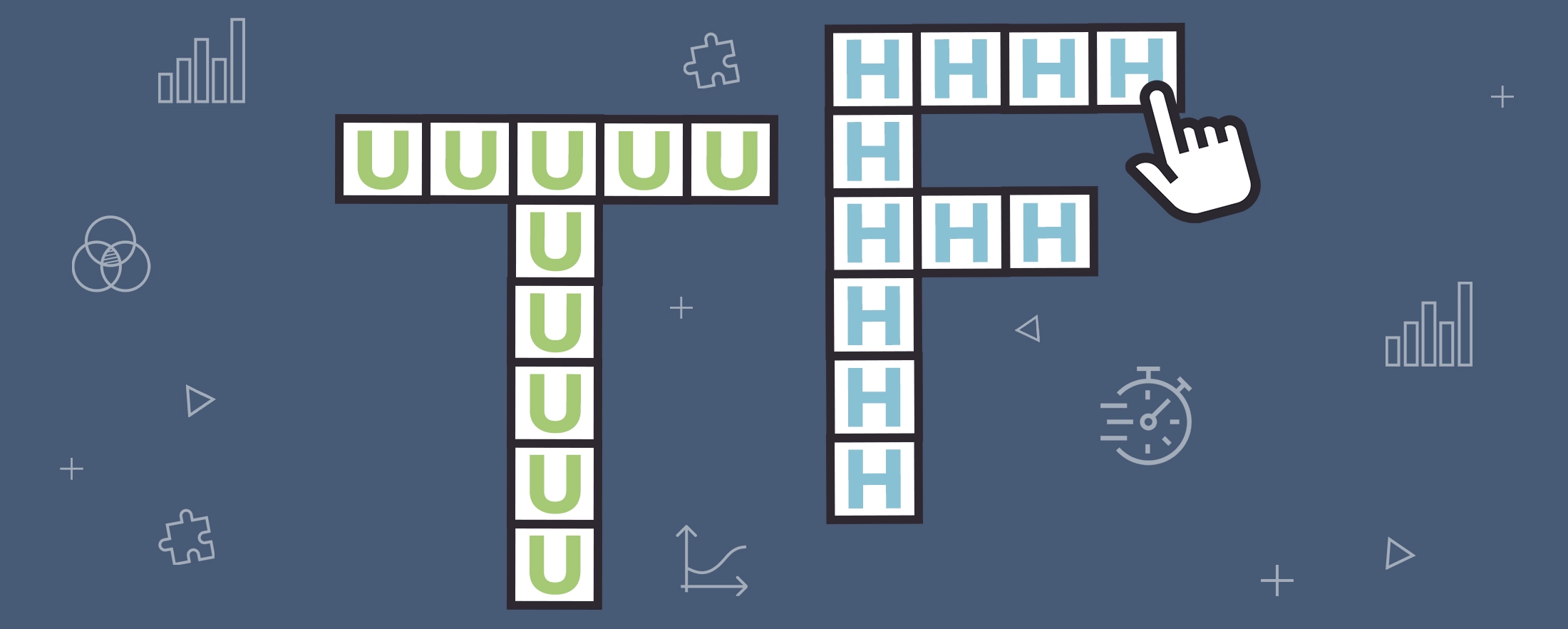
The Navon Task
The Navon task is a classic cognitive task used to explore how individuals process and perceive visual information. The Navon task involves the presentation of stimuli of large figures made up of smaller figures and this investigates whether people notice the ‘big picture’ (global features) or the ‘details’ (local features) first. The Navon task is simple but reveals a lot about perception and has been utilized widely in research and clinical setups!
History of the Navon Task
The Navon task was introduced in 1977 by the psychologist David Navon. In his paper titled “Forest before trees: The precedence of global features in visual perception" he wanted to understand how individuals process visual stimuli– Is it as a whole? Is it feature by feature? Or is it somewhere in between?
The Navon task was developed in order to examine this. The task contained a compound stimulus that includes both global (whole) and local (component) features. His findings revealed that individuals tend to respond to global features faster than to local features and that when the global and local features are incongruent, the global features tend to interfere with the recognition of local features (Gerlach & Poirel, 2018; Navon, 1977).
Since its introduction, the Navon’s paradigm has become a classic tool in various domains of research.
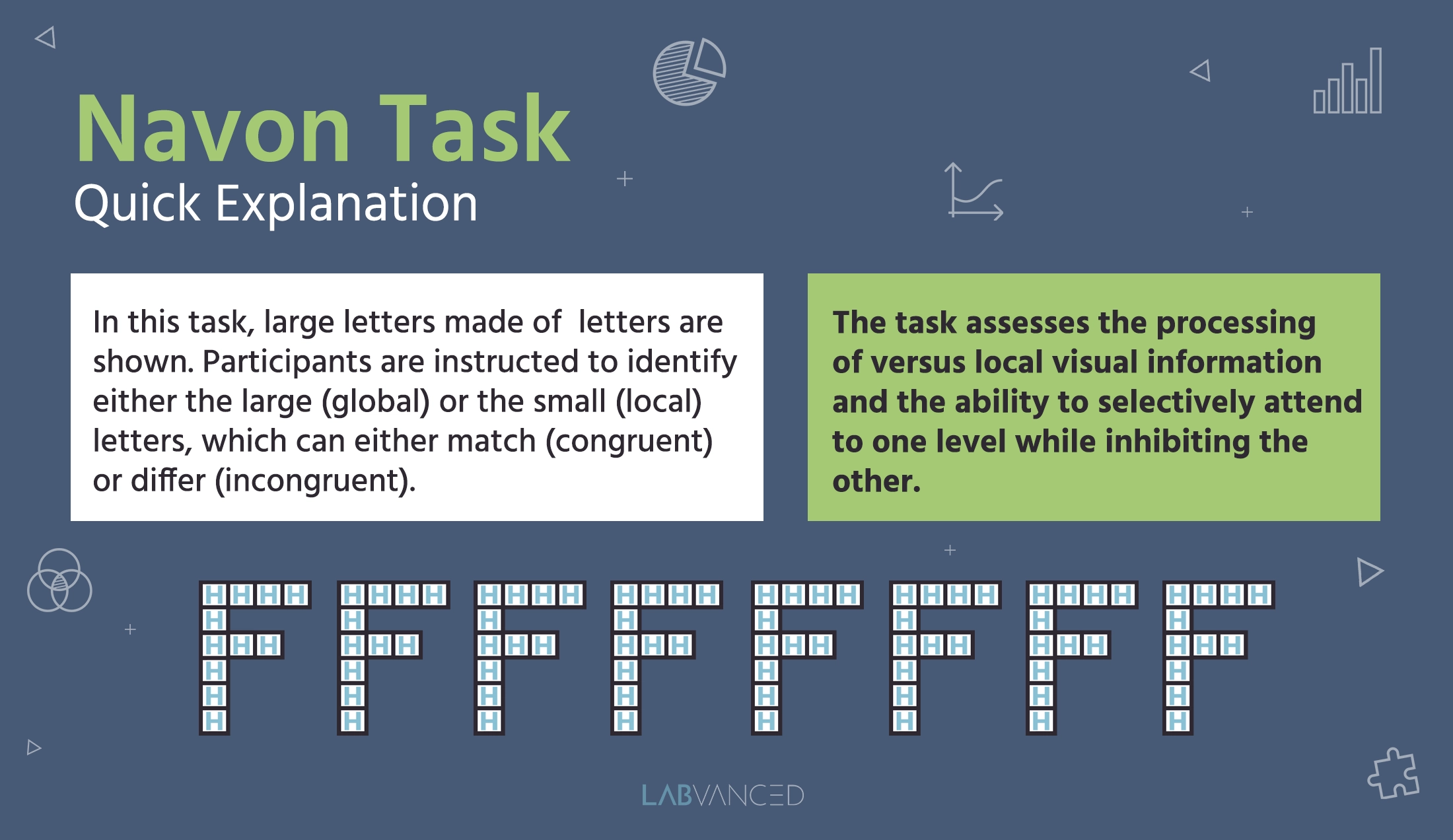
Navon Task Experiment Description
The typical Navon task involves presenting participants with visual stimuli that are composed of hierarchical features– large letters composed of smaller ones. These features are mainly of two types:
- Global features: Global features refer to the larger letters or shapes that form the overall structure of the stimulus. It is what you tend to notice at first glance. It represents the whole form rather than the parts it's made up of. For example, in the image below, the global features are the large letters “E” and “H”.
- Local features: These are the smaller letters or shapes that are repeated and grouped together to form the global feature. In the image below, the local features are the “E’s” that are used to create the global features “E” and “H”.
The relationship between the global and local features can also vary, resulting in two main types of stimuli:
- Congruent stimuli: The global and local features are the same. For example, in the image below, the first stimuli presents the global feature “E” which is made up of local features “E”.
- Incongruent stimuli: The global and local features are different. In the image, the second stimuli presents a global feature “H” while it is made up of local features “E”.
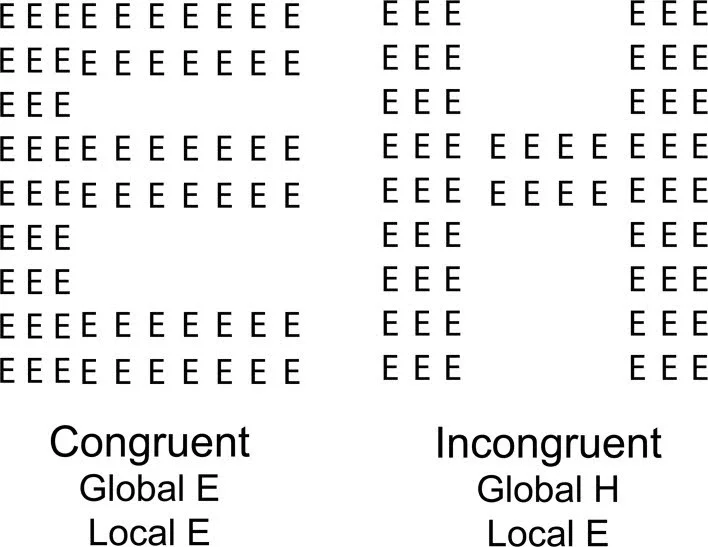
An example of a Navon task stimulus; Watson, T. L. (2013).
The participants are presented with either congruent stimuli or incongruent stimuli and are prompted to identify either the global or local feature of the presented stimuli. However, the specific prompt would vary depending on the experimental condition.
For example, in the Navon task online in Labvanced, the participants are prompted to press the “B” key if they see either the letter “H” or “O” (small or large) and to press the “N” key if they see neither “H” or “O”. You can try it out here by clicking on the Participate button under the study description or Import it to your account to edit it freely.
Data Collected
The Navon task enables the collection of various behavioral and physiological data.
- Reaction Time (RT): The time taken to identify global or local features. Faster RTs for global features often indicate a global processing bias and for local features indicate local processing bias.
- Accuracy: The correct identification of the required feature (global/local).
- Physiological measures: Physiological measures can be captured as well while administering the Navon Task. Common methods include EEG for brainwave activity, FMRI for neural activity and eye tracking to quantify gaze and fixation patterns. For online versions, it is also possible to activate Labvanced’s peer-reviewed webcam-based eye tracking to collect gaze data.
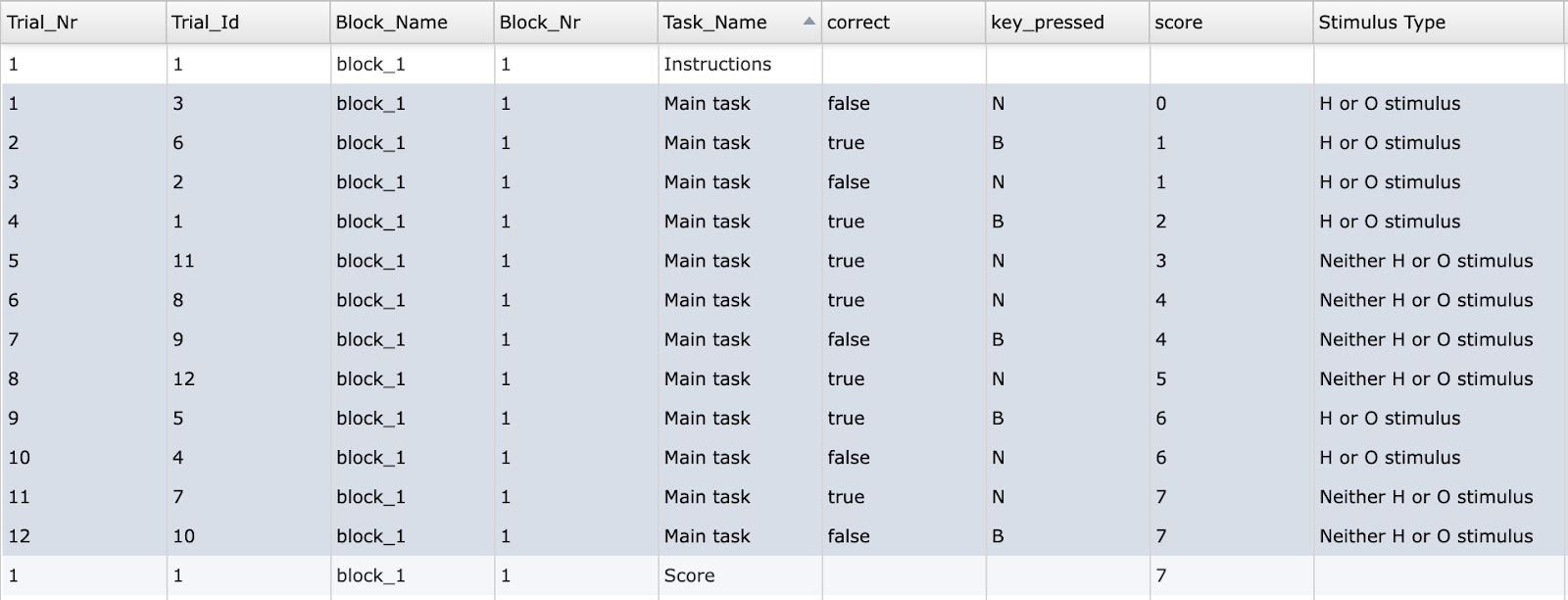
In the image above, you could see what the data collected looks like when it is being recorded in Labvanced. The data shows the basic details of the task such as the trial number, id, the block name and number, and the task name (i.e, if it’s the instructions, the main task or the score feedback). Additionally, further task-specific data is collected such as correctness, the keys pressed for during each trial, the running total score, and the type of category the target stimuli belong to.
Possible Confounds to Consider
There are different factors that could affect the performance in Navon Task, ranging from stimuli presentation, participant factors, as well as individual differences like cognitive processes:
Navon Task Stimuli and Presentation
- Exposure Duration: If a stimulus is presented for a very short time, the observer may not have enough time to fully process the local details, leading to a stronger reliance on the global features (Kimchi, 1992).
- Number of Elements: If participants are presented with many local features, they might rely more on the global properties due to the overwhelming number of local elements and if the local features are less in number, participants might have a tendency to focus more on the local details. These variations can confound the interpretation of the results (Kimchi, 1992).
- Eccentricity: Eccentricity refers to the distance from the fovea (the central point of the retina) to the visual stimuli. Objects closer to the fovea are seen more sharply. Since global features are spread out, they may be subject to lower sharpness of vision as compared to local features (Kimchi, 1992).
Participant Factors and Individual Differences
- Sex and sex hormones: Sex hormones like testosterone affect how the brain processes global and local features in the Navon task. For example, in men, stronger brain connectivity between hemispheres (which is linked to testosterone) leads to better global processing (Pletzer & Harris, 2018).
- Mood / Emotional State: Individuals with distress and in a low mood are relatively slower and less accurate at identifying the global features as compared to individuals with no distress and a more neutral or positive baseline mood (Kabre & Srivastava, 2024).
- Processing Speed: Individual differences in general processing speed can affect reaction times and potentially the strategies individuals use to perform the task (Ashkenazi & Blum‐Cahana, 2022).
- Carry-over effects: If a participant performs several trials focusing on the global level, this might create a "carry-over" where they continue to preferentially attend to the global level even when they're supposed to switch to the local level (or vice-versa) (Trawiński et al., 2023).
- Culture: Studies have shown that East Asians tend to have a stronger global processing advantage compared to Caucasian Westerners when tested using Navon figures. This preference for global processing is theorized to be influenced by cultural factors, such as individualism and collectivism (McKone et al., 2010).
What is Labvanced?
Labvanced is a powerful platform designed specifically for conducting behavioral and cognitive experiments and psychological research using advanced features such as peer-reviewed eye-tracking and multi-user study support via web and native desktop/mobile applications.
Psychology of the Navon Task
The Navon task has been utilized to explore how people attend to and process hierarchical stimuli and visual structures. But how does the task help in this understanding? The Navon paradigm has helped uncover different patterns, cognitive processes and present an understanding of how visual stimuli are interpreted by different individuals. Let us look into it in detail:
Purpose of the Navon Task
The Navon task has been widely utilized across various fields to understand different aspects of visual processing. Here are a few:
- Precedence: This refers to the tendency to identify a target fastest either at the global level or local level, especially in hierarchical stimuli (e.g., a big letter made up of small letters) (Tess & Kruk, 2022).
- Perceptual Processing: Perceptual processing is the process by which individuals perceive and prioritize visual details. One of the key purposes of the Navon task is to understand how we perceive visually presented hierarchical stimuli (Gerlach & Poirel, 2018a).
- Attention Resolution (AR) Efficiency: This refers to how efficiently attention can be focused and shifted between global and local levels. High AR efficiency means better control over what level is being attended to (Tess & Kruk, 2022).
- Inter-level interference effect: Participants typically respond faster to global features than to local ones. However, when the global and local features are inconsistent (e.g., a large "H" made up of small "E" letters), the interference can lead to slower response times, particularly when identifying the local elements (Gerlach & Krumborg, 2014).
The Navon task has also led to insights into:
- Global precedence Effect: The tendency to process the "global" features of a visual stimulus before noticing its smaller, "local" components.
- Consistency Effect: Participants respond faster to hierarchical stimuli when the global and local letters are the same (consistent) compared to when they are different (inconsistent) (Gerlach & Krumborg, 2014).
- Processing Bias: A tendency or preference to focus on one type of information over another. In a Navon task, a person could either exhibit Global processing bias (focus on global features over local ones) or Local processing bias (focus on local features over global ones) (Gerlach & Poirel, 2018b).
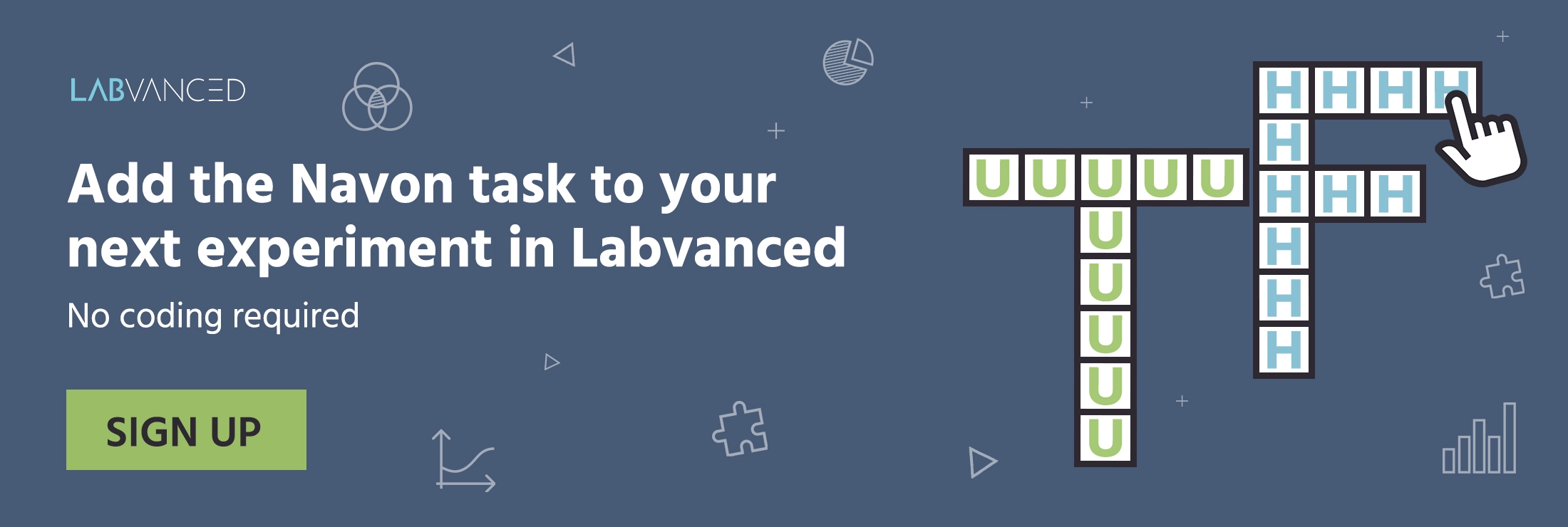
Associated Cognitive Functions
The several core cognitive functions that help in Navon tasks are the following:
- Visual Selective Attention (VSA): VSA refers to the ability to focus on certain aspects of a visual scene while ignoring irrelevant information. In the context of the Navon Task, the challenge is to process and prioritize either the global features or local features as required (Hokken et al., 2024).
- Divided Attention: Divided attention is the ability to process more than one piece of information at a time. During the Navon task, participants are required to search for targets at both the local and global levels simultaneously, which tests their ability to manage divided attention.(Lee et al., 2021).
- Working memory (WM) load: Refers to the amount of information that a person can hold in mind while performing cognitive tasks in the Navon task. High WM load can increase interference from global features when attending to local features (making it harder to ignore the global feature). But, when it comes to focusing on global features, high WM doesn’t cause much interference (it is easier to ignore the local features.) (Ahmed & de Fockert, 2012).
- Inhibitory control: Inhibitory control helps the participants manage their impulses and responses. In a Navon task, this helps participants to stop themselves from impulsively responding to the first thing they see (either the global or the local feature) and instead focus on what they are supposed to be looking for (Ashkenazi & Blum‐Cahana, 2022).
Variations of the Navon Task
In a standard Navon task, participants are presented with a large letter (global feature) made up of smaller letters (local features). Usually, people are faster at identifying the large letters. However, there are numerous variations of the task that have come up since the development of the original Navon task.
Navon Task Stimuli Examples
The variations in Navon tasks are in different forms, starting from the type of stimuli used as the global and local features. The stimuli could be in the form of numbers, shapes, or even letters (Ashkenazi & Blum‐Cahana, 2022).
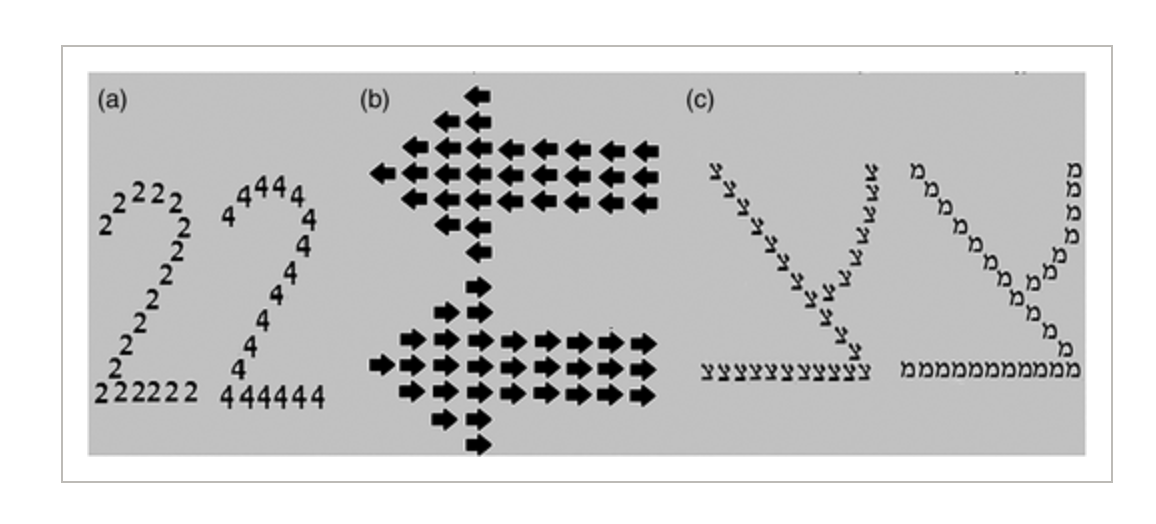
Examples of stimuli of the Navon task: (a) numerical, (b) arrow, and (c ) Hebrew letters; Ashkenazi & Blum‐Cahana, 2022.
When we look into research we could see various examples of how different stimuli were utilized and also how other variations were incorporated in the Navon task to study various cognitive functions and behaviours. Here are a few examples from research:
Reduced-Salience Navon Task
This variation adopted a “Large letter condition” in which global letters consisted of only a few local letters, which varied in size and were also irregularly spaced. These changes were intended to remove the usual global advantage seen in participants (Noguchi & Tomoike, 2016).
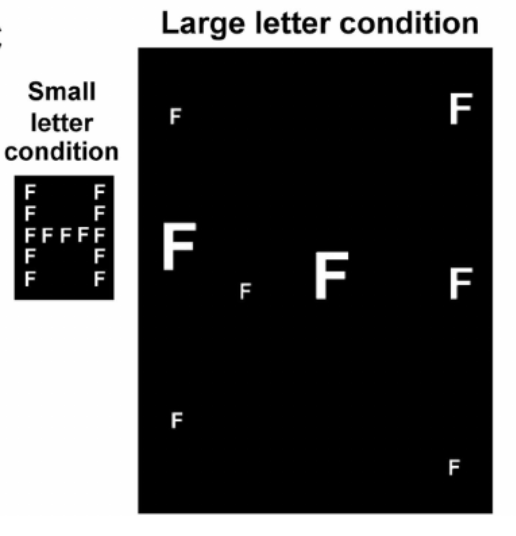
Navon letters in large-letter conditions; Noguchi & Tomoike, 2016.
Navon Shape Task
In this variation, participants are presented with large shapes made up of smaller shapes, and they must identify whether a square or a circle is present at the global level (large shape) or local level (small shape). The task involves multiple trial types and the trials are organized into pairs to assess how well participants can switch their focus between these levels (e.g., global-global, local-local, local-global, global-local) (Chamberlain & Wagemans, 2015).
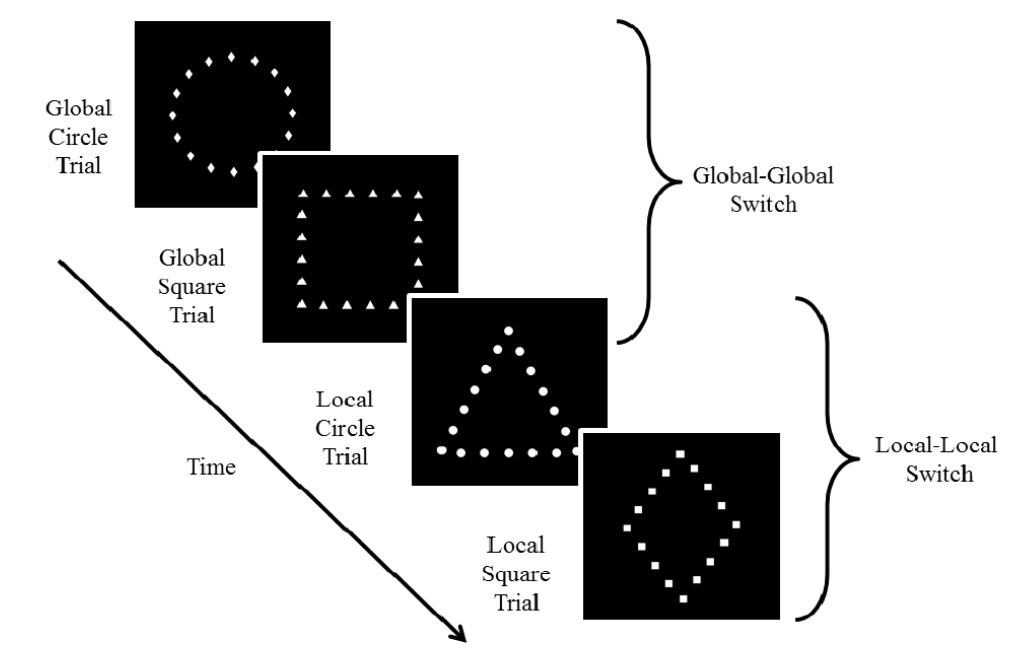
Examples of the four trial types and two switching types (GG-LL); Chamberlain & Wagemans, 2015.
The Navon Number Task
The Navon Number Task consists of large global forms (numbers) that are composed of smaller local elements (also numbers). The task consisted of three sets and each included one practice set (participants are instructed to name the number they see first as quickly as possible) and three test sets (name either global or local feature as required). The variation also incorporates eye tracking to analyze gaze behavior of the participants (Hokken et al., 2024a).
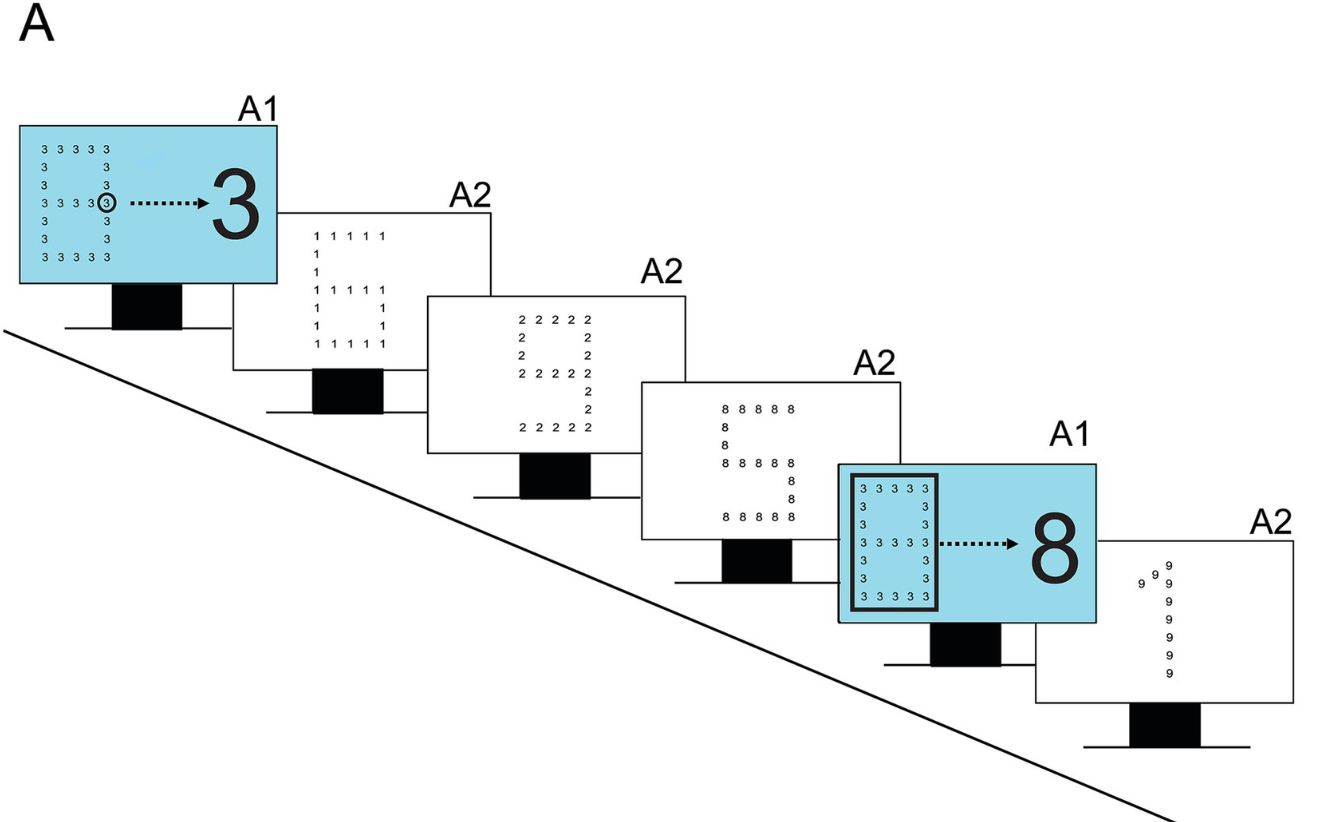
Experimental design of the Navon Number Task; Hokken et al., 2024a.
Combined Navon Global-local-stop-signal Task
This study integrated the Navon task with a stop-signal task where participants had to respond to the global or local letters unless a stop signal (a face with an emotional expression) appeared, in which case they had to inhibit their response. This combination allowed them to examine how global vs. local processing of the letter stimuli interacts with the emotional content of the stop-signal faces (angry, happy, neutral) to influence response inhibition (Pandey & Gupta, 2023).
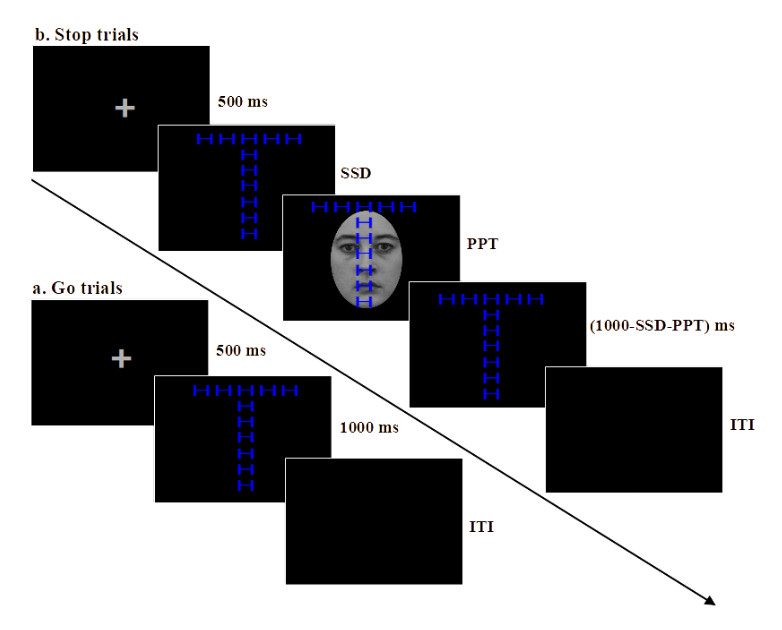
Example of task progression in Combined global-local-stop-signal task; Pandey & Gupta, 2023.
Navon Task Across Psychology Fields
The Navon Task has been administered across many fields for various reasons, here are a few examples:
- Clinical psychology: The Navon task has been administered to help identify biases in attentional focus and perceptual styles, which can be indicative of conditions like autism, ADHD, brain injury, and difficulties with face processing. By examining interference between global and local levels, the task offers a concise method to understand fundamental aspects of cognition relevant to various clinical presentations (Hokken et al., 2024).
- Developmental psychology: In developmental psychology, the Navon task assesses how global and local processing skills evolve as children grow and as adults age. Researchers use it to track the development of the typical preference for seeing the "big picture" first (global precedence) and how the ability to focus attention at different levels changes with age. By comparing these patterns in typically developing children and those with developmental conditions like dyslexia or autism, the task helps understand variations in perceptual and attentional development and the impact of factors like learning (Morris, Dumontheil, & Farran, 2021).
- Neuropsychology: In neuropsychology, the Navon task helps understand how brain injury and neurological conditions impact the processing of complex visual information and attentional control, but also how the brain processes information on a functional level in healthy populations. The Navon Task is used to evaluate visual processing at different levels, identify biases towards global or local features, and assess attentional shifting between these processing levels. By examining performance on this task, researchers and clinicians can gain insights into specific perceptual and attentional processes (Hausinger et al., 2025).
Conclusion
The Navon task is a popular tool in visual cognition research, especially in understanding how we prioritize information in our visual field. Its flexibility and simple design has made it a popular tool in research across various fields and continues to do so by offering insights into how various cognitive functions and behaviours are carried out!

References
Ahmed, L., & de Fockert, J. W. (2012). Working memory load can both improve and impair selective attention: Evidence from the Navon paradigm. Attention, Perception, & Psychophysics, 74(7), 1397–1405.
Ashkenazi, S., & Blum‐Cahana, I. Y. (2022). The role of inhibition and speed of processing in mathematics. Applied Cognitive Psychology, 37(1), 111–124.
Chamberlain, R., & Wagemans, J. (2015). Visual Arts training is linked to flexible attention to local and global levels of visual stimuli. Acta Psychologica, 161, 185–197.
Gerlach, C., & Krumborg, J. R. (2014). Same, same — but different: On the use of Navon derived measures of global/local processing in studies of Face Processing. Acta Psychologica, 153, 28–38.
Gerlach, C., & Poirel, N. (2018a). Navon’s classical paradigm concerning local and global processing relates systematically to visual object classification performance. Scientific Reports, 8(1).
Gerlach, C., & Poirel, N. (2018b). Navon’s classical paradigm concerning local and global processing relates systematically to visual object classification performance. Scientific Reports, 8(1).
Hausinger, T., Reisinger, P., Weisz, N., Hansen, A., Harris, T. A., & Pletzer, B. (2025). Spatio‐Temporal Decoding of the Navon Task Challenges Rigid Hemispheric Asymmetries in Global–Local Processing. Psychophysiology, 62(3), e70032.
Hokken, M. J., Van Der Zee, Y. J., Pereira, R. R., Rours, I. G., Frens, M. A., van der Steen, J., Pel, J. J., & Kooiker, M. J. (2024a). Gestalt, Navon and Kanizsa Illusion Processing in CVI, ADHD, and dyslexia children with Normal Verbal IQ. Frontiers in Human Neuroscience, 18.
Hokken, M. J., Van Der Zee, Y. J., Pereira, R. R., Rours, I. G., Frens, M. A., van der Steen, J., Pel, J. J., & Kooiker, M. J. (2024b). Gestalt, Navon and Kanizsa Illusion Processing in CVI, ADHD, and dyslexia children with Normal Verbal IQ. Frontiers in Human Neuroscience, 18.
Kabre, M., & Srivastava, P. (2024). Predisposed Mood and Music in Perceptual Judgement Task. Proceedings of the Annual Meeting of the Cognitive Science Society, 46. Retrieved from https://escholarship.org/uc/item/4920c3h3
Kimchi, R. (1992). Primacy of wholistic processing and global/local paradigm: A critical review. Psychological Bulletin, 112(1), 24–38.
Lee, L. Y., Talhelm, T., Zhang, X., Hu, B., & Lv, X. (2021). Holistic thinkers process divided-attention tasks faster: From the Global/Local Perspective. Current Psychology, 42(7), 5415–5427.
McKone, E., Davies, A. A., Fernando, D., Aalders, R., Leung, H., Wickramariyaratne, T., & Platow, M. J. (2010). Asia has the global advantage: Race and visual attention. Vision research, 50(16), 1540-1549.
Morris, S., Dumontheil, I., & Farran, E. K. (2021). Responses to Navon tasks differ across development and between tasks with differing attentional demands. Vision Research, 185, 17-28.
Navon, D. (1977). Forest before trees: The precedence of global features in visual perception. Cognitive Psychology, 9(3), 353–383.
Noguchi, Y., & Tomoike, K. (2016). Strongly-motivated positive affects induce faster responses to local than global information of visual stimuli: An approach using large-size Navon Letters. Scientific Reports, 6(1).
Pandey, S., & Gupta, R. (2023). Happy faces facilitate inhibitory control under a narrow scope of attention. In Proceedings of the Annual Meeting of the Cognitive Science Society (Vol. 45, No. 45).
Pletzer, B., & Harris, T. (2018). Sex hormones modulate the relationship between global advantage, lateralization, and interhemispheric connectivity in a Navon Paradigm. Brain Connectivity, 8(2), 106–118.
Tess, V. A., & Kruk, R. S. (2022). The Navon task as a measure of attention resolution efficiency in children and adults. Journal of Vision, 22(14), 3792.
Trawiński, T., Mestry, N., & Donnelly, N. (2023). The effect of prior viewing position and spatial scale on the viewing of paintings. Vision, 7(3), 55.